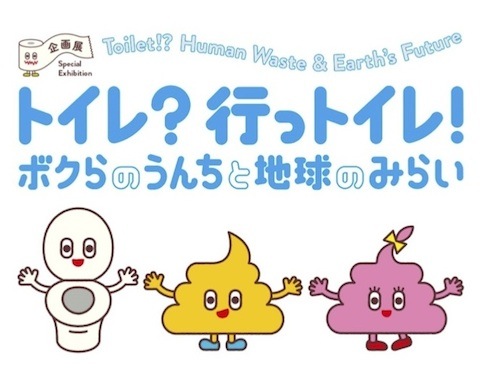Water
Special Exhibition on "Toilet!? Human Waste & Earth's Future" at the National Museum of Emerging Science and Innovation
2014.07.02 Junji Hashimoto

When you hear the word, "toilet," what do you think of?
When you were little, did you ever not want to go to the bathroom at school because you felt embarrassed?
Or have you ever felt relieved to be alone.
Toilets have made our lives more hygienic and more comfortable. Nowadays, there are heated toilet seats, and we can go about our lives without even having to look at excrement. I'm sure some of you enjoy cleansing with the warm water spray.
But if we look across the world, only a small handful of people are enjoying a hygienic, comfortable lifestyle with clean toilets. There are approximately 2.5 billion people across the world living without toilets. One in four people living in developing countries defecate outdoors.
But when people defecate in the open, they are actually polluting their water source from where they get their drinking water. Defecating in the open poses additional problems for women. Because they need more privacy, they become more and more reluctant to go out, and there are many little girls who can't go to school for this very reason.
That is why new ideas for toilets are necessary.
This summer, a special exhibition on "Toilet!? Human Waste & Earth's Future" is being held at the National Museum of Emerging Science and Innovation (from July 2 to October 5, 2014) in collaboration with a children's science magazine, which encouraged people to submit their ideas for new toilets.
Around the world, toilets are continuing to evolve. For example, there are toilets that can be used in water scarce regions, toilets that can finds new use for urine and excrement, toilets with innovative shapes, and toilets for people who are physically challenged.
[Innovations for waste management]
In developing countries, many areas do not have sewage systems, so excrement and urine flow directly into rivers causing epidemics.
To address this issue, a new toilet that does not require sewage infrastructure was invented. This toilet collects urine and excrement separately, and reuses them. Urine, which is nutrient-rich, can be diluted and used as liquid fertilizer. Excrement can also be transformed into fertilizer by mixing it with ash and sanitizing it over a period of 6 months. Excrement and urine can be safely returned to earth in a way that benefits plants.
So this toilet offers 3 key solutions - improves hygiene thereby reducing infectious diseases, creates fertilizer that increases crop yields, and reduces spending on chemical fertilizers and pesticides. Urine and excrement, which was thought of as waste, can now become part of the cycle where "fertilizer" helps "grow plants" that "people eat."
[Innovations for toilet shapes]
During the Heian period in Japan, princesses wore 12-layered kimonos, and their hair was very long, trailing behind them as they walked. They also used portable wooden toilets known as "okebako." These toilets contained sand or ash inside for deodorization.
In Europe, there were chair-shaped toilets, which were used as regular chairs when not being used as toilets.
Portable toilets still exist today. For example, there are portable toilets for people who are receiving nursing care at home. These toilets also feature numerous ingenious functions. For instance, at a touch of a button, the armrests on the toilet descend making it easier to move from the bed to the toilet. And by using springs, toilet lids may be opened without applying much force.
Portable toilets are also very useful in times of emergency. After the Great East Japan Earthquake, sewage systems in the affected areas were disrupted. And in areas where power outages persisted, many people were afraid to go to temporary toilets. Nowadays, mothers with small children use portable toilets at home.
[Innovations for bathrooms]
Sen no Rikyu, known as having had the most profound influence on the Japanese art of tea ceremony and as an excellent provider of hospitality, was also very interested in toilets. He developed a new toilet, Suna-secchin for the warlord, Hideyoshi Toyotomi, which resembled a beautiful rock garden with small boulders and gravel.
The bathroom environment continues to evolve both in terms of comfort and functionality. Bathrooms in schools are brighter and cleaner, and even fun to use. Some have large mirrors, shelves for your belongings, and the walls and floors are painted in fun colors.
Multi-purpose toilets in public facilities are also equipped with numerous functions convenient for a wide range of people like mothers and fathers with babies or physically challenged people. So innovations for toilets come in all shapes and sizes. Why not download an application and submit your unique ideas for toilets? (Deadline is July 30). Best ideas from all the concepts submitted will be showcased at the special exhibition on "Toilet!? Human Waste & Earth's Future" to be held at the National Museum of Emerging Science and Innovation (from July 2 to October 5, 2014).
Related URL/media
http://www.miraikan.jst.go.jp/sp/toilet/index-en.html
![]()








